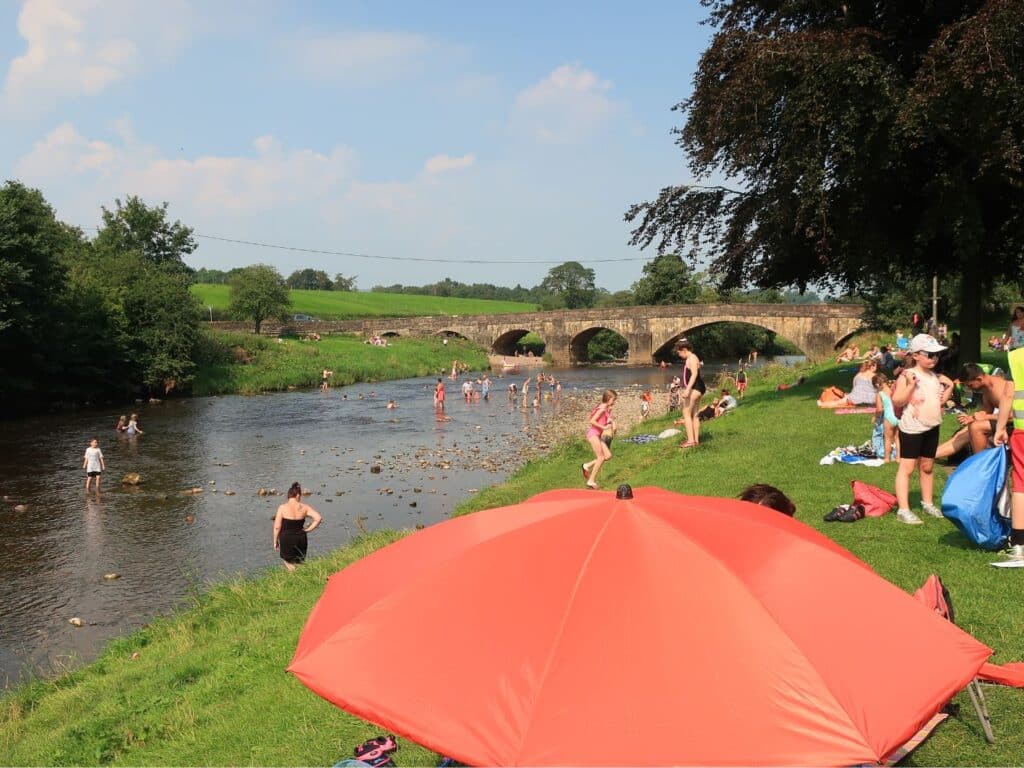
water safety tips for river explorers
keeping river explorers safe
The Ribble catchment is a great place to have fun and engage in recreational activities, especially during the warmer months, but when you’re near the water you always need to think of your safety!
Activities like wild swimming, kayaking, and other water-based sports are great fun for families. However, it’s important to remember that water has the potential to be dangerous if you don’t take proper precautions.
Remember, the water can be very cold, even in summer, this cold water can lead to cold water shock. There could also be hidden currents, the water could be deceptively deep, and it could be difficult to get out of. Plus, there could be hidden rubbish like broken glass, or the water could contain something that might make you ill. Even healthy rivers sometimes get naturally occurring nasties in them.
Don’t let this put you off though, our water safety tips will give you a basic guide on staying safe!

Check the weather and water conditions
Before heading out to the river or any other body of water, check the weather forecast, river levels, and bathing water information. Make sure you check the conditions in the area you are heading for, and upstream too. A deluge of rain upstream can soon travel down the river. Also, be aware of strong currents or changes in water level, as these can make swimming or kayaking dangerous. It’s worth noting that hot weather comes with it’s issues too. Water levels might be too low, which can cause damage to things like paddleboards, kayaks, and canoes. It might also mean a wasted journey!
Sadly, your river might not always be safe to swim in because of the water quality. In almost all of our rivers there is a risk of pollution- especially after heavy rain. So, before you take a dip check out the Rivers Trust sewage map. This interactive map shows the locations of waste water treatment works and combined sewage overflows, which are the most frequent sources of sewage pollution. It’s best to try and avoid swimming downstream of infrastructure like this.
BRING A BUDDY AND KEEP KIDS CLOSE

Giving your kids the chance to take calculated risks is all part of growing up and makes for great childhood adventures. But always keep youngsters close to you and close to the riverbank. Remember, in the water, silence is often a sign of danger rather than good behaviour. It’s a good idea to chat with older children and teenagers about water safety too. You can’t keep them supervised forever!
Even for experienced water users, assigning a buddy to watch you, or even just to know where you are and what time you will be back is a simple way to guarantee your safety. Water sports are much more fun with someone else anyway!
Wear a life jacket
This might not be practical when swimming. But, if you’re fishing kayaking, or paddleboarding then always wear a life jacket or buoyancy aid. Buoyancy aids are bulky, but they’re much better than lifejackets if you’re doing something that’s likely to get you wet, like paddleboarding. Life jackets come in lots of different configurations, like auto inflating or pull cord variations. Life jackets are better for times when you don’t expect to go into the river, like angling. The RNLI have some great advice which can help you choose which option is right for you.
WATCH OUT FOR WEIRS
To the average person a weir on a river is a peaceful site; a slow-moving pool of water with a miniature man-made waterfall flowing gracefully over it. However, underneath the water it’s a completely different story.
Weirs generate huge amounts of turbulence, with water flowing back in on itself like a wave, which can easily trap a person. Plus, most weirs are on old industrial sites, so you never know what is lurking below the surface. Common hidden obstructions include walls, fallen trees, rock formations, weeds, and litter like shopping trolleys.

GET TO KNOW YOUR FITNESS LEVELS
If you are planning on swimming, paddle boarding, kayaking or canoeing you can get all the gear online, but does that mean you should? It’s best to find out what your fitness levels are like first. Visiting a water sports club, or even your local swimming pool is a great way to gauge how fit you are. You’ll then know whether you can manage a cold swim in flowing water, or if you’re best putting in some practice lengths to build up your skills. This can save you money too as many sports clubs let you use their equipment for free.
Avoid alcohol
Alcohol and water don’t mix well. This might seem obvious, but alcohol can soon impair your judgment and your ability to swim. After all, most aspects of water safety are pretty instinctive, but these instincts are soon impaired when the drinks start flowing. It’s best to avoid alcohol altogether when you are planning to spend time near water.
By following these essential safety tips, you can help ensure that your family stays safe while enjoying all the water has to offer. Check out further advice from the expects at the RNLI.

